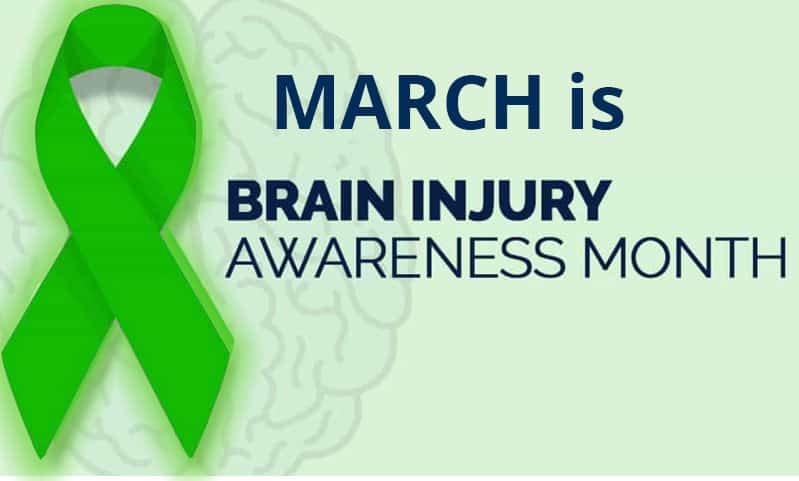One advocacy group has big plans for Brain Injury Awareness Month, highlighted by an advocacy day in Albany on March 25.
Some legislative priorities include “keeping the TBI waiver out of Medicaid managed care, expanding the Concussion Management and Awareness Act of 2011 and creating a resource facilitation program,” said Brain Injury Association of New York State President Barry Dain.
Brain Injury Awareness Month began in 1989.
Today, it focuses on all brain injury victims, and especially on young children.
According to the Centers for Disease Control, two million children a year visit hospital emergency rooms with Traumatic Brain Injuries.
Types and Causes of Brain Injuries
Acquired Brain Injuries, Traumatic Brain Injuries, and Post Traumatic Stress Disorder are the three most common types of brain injuries in New York.
Medical negligence, specifically birth injuries, causes many ABIs.
If the baby is too large to float down the mother’s narrow birth canal, the umbilical cord could wrap itself around the baby’s neck and cause hypoxia (lack of oxygen).
A few minutes of oxygen deprivation causes cerebral palsy and other serious ABIs.
During prenatal visits, doctors should be able to spot the warning signs of shoulder dystocia. Yet for various reasons, they either do not see the red flags or they choose to ignore them.
Either way, the doctor is probably negligent, primarily because the doctor-patient duty of care is so high.
Misdiagnosis also comes into play in other types of ABIs. A number of chronic conditions, like heart disease and diabetes, can also cause hypoxia. Assuming the doctor promptly diagnoses and properly treats the disease, adult-onset ABIs should never happen.
Car wrecks are the leading cause of Traumatic Brain Injuries. These incidents combine all three major TBI causes, which are:
- Trauma: Skulls are not very thick. Striking an airbag at 60mph is more than enough force to cause a TBI. Related injuries, such as whiplash, are rather common as well. The neck has basically no protection at all in a car crash.
- Motion: Sometimes, car wreck victims have brain injuries before their heads hit anything. The sudden, violent motion is usually sufficient to cause a brain injury. Contrary to popular myth, the brain does not fit snugly against the skull. When a person’s head moves, the soft brain slams violently, and repeatedly, into solid bone.
- Noise: Witnesses often say that car crashes sound like explosions. These sudden, loud noises create shock waves which disrupt brain functions. That’s the primary reason so many Iraq and Afghanistan War veterans struggle with TBIs.
Falls, assaults, and other unintentional injuries also cause a number of TBIs. Swimming pool drownings cause many brain injuries as well. These wounds could be categorized as TBIs are ABIs.
For years, researchers believed that PTSD was a processing disorder.
Now, researchers know that PTSD is a physical brain injury. Exposure to combat-like stress triggers a chemical imbalance in the brain.
The cerebral cortex, which controls logical responses, shrinks. As a result, the amygdala, which controls emotional responses, expands.
This imbalance explains symptoms like:
- Depression,
- Nightmares,
- Flashbacks,
- Loss of interest,
- Sleeplessness, and
- Rage against family members.
Military veterans often suffer from PTSD, as do firefighters, police officers, and other emergency responders.
Diagnosis and Treatment
All these injuries are difficult to diagnose. Generally, the brain is very adept at concealing its own injuries.
That’s why many concussed athletes ask their coaches to put them back in the game.
When they tell their coaches they “feel fine,” they mean it. These individuals do not realize how seriously they have been hurt.
So, if you were injured in a car crash or other such incident, always have a New York personal injury attorney refer you to a doctor. That’s the only way to determine how badly you were hurt.
Additionally, many brain injuries do not trigger signature symptoms, such as unconsciousness. So, many doctors misdiagnose head injuries as shock from the accident or something else.
These victims are not properly diagnosed until they experience more advanced symptoms, such as personality changes and intense headaches.
All brain injuries are incurable. Once brain cells die, they never regenerate. However, a combination of surgery and physical therapy usually alleviates the symptoms.
Surgery usually means reducing brain swelling, which keeps the injury from getting worse. This option is usually only available in TBIs.
Brain injury physical therapy is nothing like broken bone physical therapy.
The brain injury PT process is long, and progress is uneven. However, if neither the therapist nor the victim give up, progress will eventually occur.
Compensation in a brian injury case normally includes money for economic losses, such as medical bills, and noneconomic losses, such as pain and suffering.
Additional punitive damages might be available as well, especially in medical negligence cases.
Brain injuries cause lifelong injuries. For a free consultation with an experienced personal injury attorney in New York, contact Napoli Shkolnik, PLLC. You have a limited amount of time to act.
